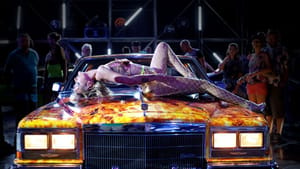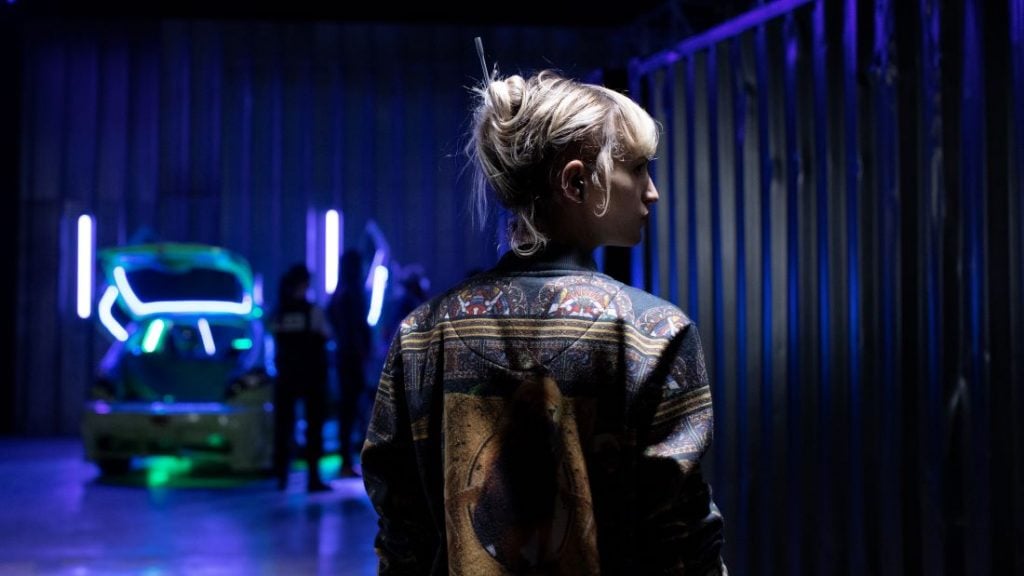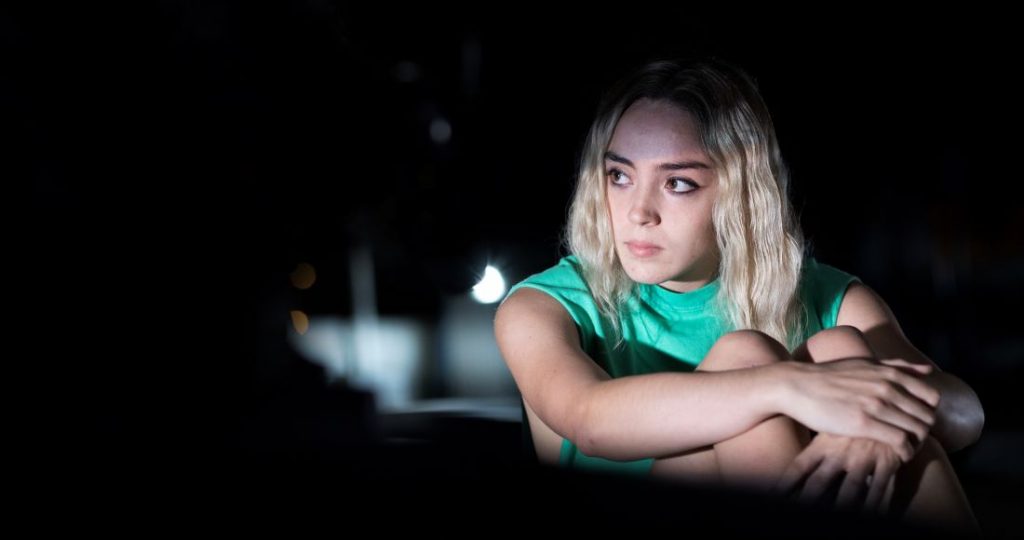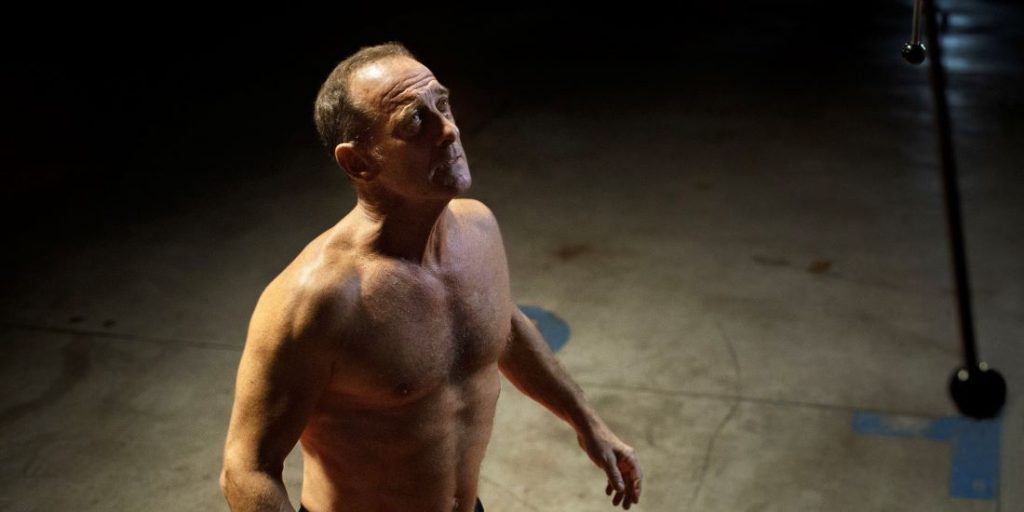
Julia Ducournau jokes that a film set is “the only place on earth where your actual character defects are an asset.” The writer-director is talking about her tendency to go all in with every shot, first in the 2016 horror film Raw — so intense that it made festival audiences faint — and now in Titane, winner of the Palme d’Or at Cannes. On the Titane set, she and cinematographer Ruben Impens established the go-for-broke tone on the first day by making the production’s first shot a jaw-dropping, unbroken sequence, or “oner,” in which a model played by Agathe Rousselle walks through a car-show crowd and performs a provocative dance on the hood of a flame-emblazoned Cadillac. Impens says the entire crew felt like they were competing in the Olympics. In this conversation, the French director and Belgian cinematographer talk about steering into danger.
Julia Ducournau: In Raw, we hadn’t used a lot of machinery. You and I were pretty frustrated with that, and we wanted to use more for Titane — to have a bit more ambition with the camera moves.
Ruben Impens: The first thing I remember you said is, “We have to take this to another level, Ruben!”
Ducournau: I’m pretty sure the next movie is gonna be on another level. I think it will always be on another level. Titane is a very intimate film. It’s really close to the bodies, and it’s really closed in around the two characters. So in order to have a counterpoint, we decided to also create big scenes with more amplitude, in order not to be too claustrophobic about this intimacy.
Impens: From the start we knew we were not looking for any anamorphic feel for the lenses. We were not looking for old glass and a lot of artifacts. We wanted something spherical. We wanted a crisp, sharp and modern look.
So from there, the choices are fairly easy. The larger format of the ALEXA LF gave us the scope to play with wide lenses and have a limited depth of field. We wanted close focus, to be able to have characters close to the lens, and at the same time, let them walk away and still be able to follow with the focus. We shot Raw on Zeiss super speeds which was OK, but sometimes frustrating. Especially for the wider shots, there was a lack of definition, sharpness.
Ducournau: It was also how you filmed the skin. I like to show the skin in very close detail. It has to look organic, especially since we use a lot of fluids in the film. When we knew we wanted to splurge a little bit more into machinery, my first reflex was like, But wait, I like to be close to the bodies, I like handheld, I like its energy, I like something that is a bit raw, a bit organic. I remember saying we could not lose that either. It was not going to be a movie with full machinery, super-sleek, super-slidey, super-clean. I did not want to lose the organic part that we had in Raw, so we pushed even more here with the handheld. The line for this is that you have to always feel what the characters feel. So you’re constantly in touch with the characters, no matter what. This is actually a question for me of camera angles more than camera movements.

Agathe Rousselle as Alexia in Titane, from writer-director Julia Ducournau. Photos by Carole Bethuel/NEON
The Car-Show Oner
Julia Ducournau: I love oners. The more difficult, the better. Oners with big technical challenges are the best way to have a team work together. Everyone involved is committed to it, because it’s hard for everyone.
This oner was the first day of shooting. I’m very glad we started with this because it made us start on a very striking, high note, which was good for everyone in terms of energy. The combination of the Ronin, the crane — which was one of the biggest challenges, along with a lot of set and sound challenges — it was, all in all, a very hard shoot, but we did it right.
Ruben Impens: It was such an incredible buildup. We didn’t even start yet, and it was like we were going to the Olympic Games. It was fun.
The advantage was that we really took the time to prep it, rehearse it, map it out, tape it out on the floor, slowly bringing in cars, doing the whole choreography, and then synchronizing the technical aspects. One of your qualities, Julia, is that you’re very fast in analyzing a shot. Some directors take their time, but when we do a take: This, this, and this, I want to change.
This is awesome, especially if you’re doing something like a oner, because I’m busy with lights, I’m framing the last part of it, so sometimes for me, it’s hard to judge. There are so many things to look at. You know how to tweak something and push it in the right direction to make it work. I don’t know which take we used…
Ducournau: Out of 37, I think we used the 10th. But in the edit I found myself with at least eight or nine that could have made it to the screen, easily. We did a really amazing job that day, because the energy was there. We had practiced, and everyone had fantasized about this shot for so long. We had this first day of prep, and we did it without the extras. And we taped everything, all the cameras, every landmark in the shot, and then the next day, 300 people arrived, and they fucked everything up.
Impens: Of course.
Ducournau: When our second camera — who was doing the Ronin — saw all the extras, he went white. He was like, “Fuck, I can see my marks anymore!”
The way I work on set, is that no one sees anything. Never. No replays, except for technical issues, which we did a little bit on this one. No one watches the rushes, apart from my editor and my producer. I don’t watch them either. The idea is to go all in, every time.
Unfortunately, for me, and my close ones, I am like this in life. And that is a bummer outside of a set, I can tell you. When you think about it, when you’re directing your film, it’s the only place on earth where your actual character defects are an asset.

The lead in Julia Ducournau’s Raw, Garance Marillier returns for Titane. Main image (above): Alexia (Agathe Rousselle) dances on the Cadillac at the end of the car-show oner in Titane.
Instincts + Preparation
Julia Ducournau: We definitely talk through all of the visual territory of the film way ahead. I often feel that we both have the same instinct for scenes in terms of colors and stuff like that, and we can’t really explain why. But it’s like, Yeah, it feels good for this one. It’s weird, because at the same time, we’re very thorough in this.
Ruben Impens: But compared to other scripts, your script is very precise.
Ducournau: Again being the control freak!
The more precise in the preparation you are, involving the shot list and stuff like that, the more you can allow yourself to actually go another route, because on set, it doesn’t work that well as well as you had imagined first.
I cannot enter the set without my shot list. I need it even though I know that I might not respect it fully.
Also read: Heartland International Film Festival Celebrates 30th Anniversary With a Lineup for the Ages
Impens: It comes together with the shot list. You’re like, No, we have to cut down one shot. We don’t have the time to do this, Ruben! It’s so funny, because 90 percent of the time, it’s the opposite. The director always wants more shots.
Ducournau: I don’t think that multiplying shots makes it a good thing. Carefully thinking out your angles makes it a good shot. So I don’t mind sacrificing a shot or two, if it allows me more time to make the other shots better. And the other reason why I have to think like this and actually privilege some of the shots in order to do them well is because, man, the production is on my ass constantly!
Impens: I see it as a very positive thing. Many other times it’s a disaster. You have no idea. Many times you go in with a shot list, and you’re 100 percent sure, in advance, you’re never gonna make it. It’s impossible. You go with 27 setups, and you go to your director, I’m sorry, but that’s not gonna be possible. Then, during the day, always around lunch, they start to realize, Oh, shit. Then it’s a crisis. Can we push to the next day? What will we do with the rest? How can we compromise? It’s a horrible way of working actually.
Ducournau: If I had to work like that, I would have a heart attack mid-shoot. I would not last the whole shoot. For me, realizing you’re late already always happens on the set. But it’s something I’m deeply allergic to. Knowing that you’re not even halfway through at midday is absolutely terrible.

Vincent Lindon stars as a steroid-addicted fire chief in Titane, written and directed by Julia Ducournau.
Believing in the Script
Ruben Impens: It starts with the story. So when you read it — and I read a lot of scripts — you have to love it. Making movies is such an effort. It’s a lot of work. So you have to 100 percent believe in it. And then it’s fun.
The moments I went against my gut feeling on a story — Maybe if we do it that way, it can turn out good — you’re telling yourself lies.
Julia Ducournau: This is true for directors you’ve never worked with, but what if I proposed a script that you don’t like?
Impens: I would tell you. I would ask you: Why? What’s the value of it? I don’t see any. If I don’t understand, then I’m sure we would talk about it. And hopefully, I would come to a point where I would realize I misunderstood it, or I’m too stupid to understand it.
Ducournau: If you don’t like this script, but you like the ambition of the mise-en-scène, what do you do?
Impens: Difficult question.
Ducournau: I want it to be difficult!
Impens: It’s difficult, but I don’t think I would do it. I turned down a war movie, which was a big project and a guy I like, and sorry, but the script was just not good. The mise-en-scène, the visual challenges were huge. It was a big budget. But I had no connection with it. Doing it just to do it… unless you’re home and you have no job. But if you have the choice, and you can wait a little bit…
Ducournau: You are ruthless. You’re putting a lot of pressure on my next script.
Impens: Sometimes you receive a script and you start reading it three separate times. Then it’s like: Oof, OK.
Titane, I finished it in one go. It was impossible to predict what’s on the next page.
Ducournau: There has been a considerable evolution between Raw and Titane for us as we worked on set. But even in Raw, there were never big problems. There can be misunderstandings sometimes. It’s normal. But it was never painstaking.
Impens: My belief is that as a DP, I try to serve the ideas and to lift the ideas of the script. I’m just there for this piece, and it’s only a little part: The camera, the actors, there’s so much on a plate for a director really. So for me, it feels like OK, I’m just part of the team.
Ducournau: I don’t know which directors you’re talking about, because for me, image is incredibly important. The technical aspect for me is as important as the direction of the actors. It shows on set because I purposefully divide my time equally between both.
Impens: That’s true.
Ducournau: After I say cut, my first movement is for the actors. And I tell them what worked and what didn’t, but right away I’m with you.
Tech Box:
Camera: ARRI ALEXA Mini LF
Lenses: Zeiss supreme full frame set 21mm – 100mm
Lighting: M90, DMG mini mix, ARRI S60 SkyPanels, Astera Titan Tubes
Color Grading: Peter Bernaers @ M141 in Paris
Titane, written and directed by Julia Ducournau and lensed by Ruben Impens, is now in theaters.
Share:

